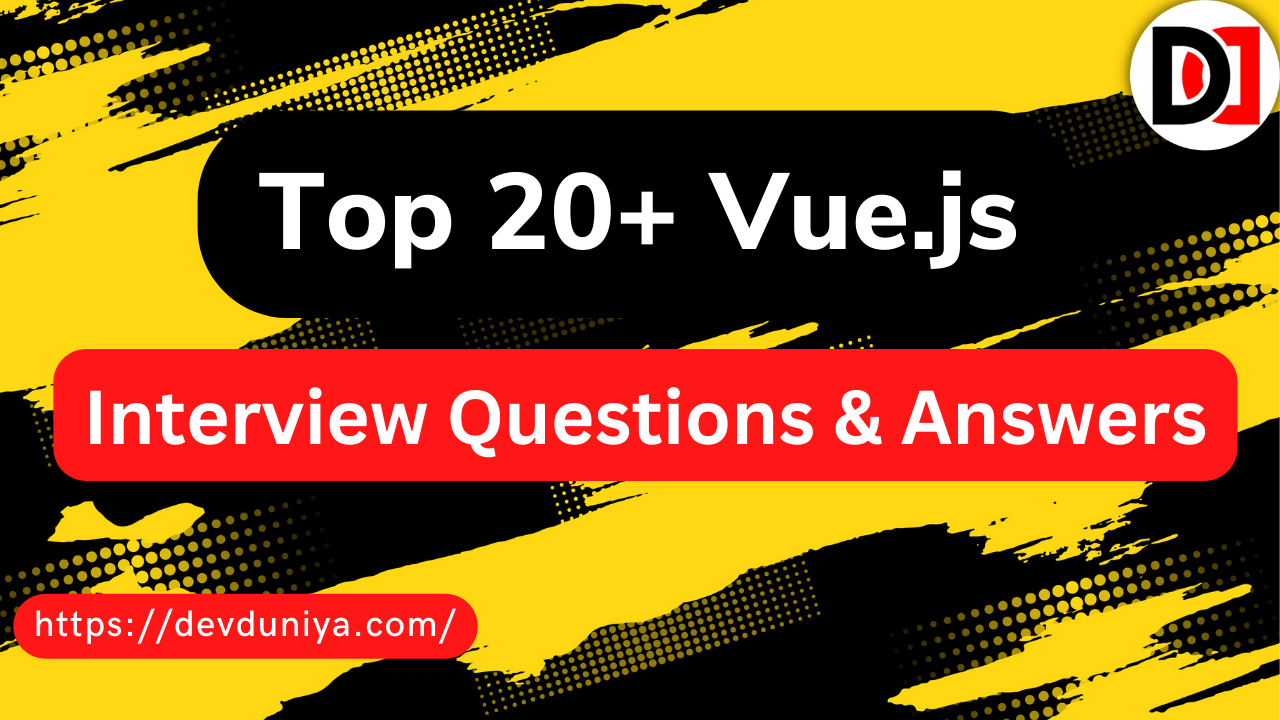ReactJS is a JavaScript library for building user interfaces. It is maintained by Facebook and a community of individual developers. React allows developers to build reusable UI components and manage the state of their applications in an efficient way.
One of the key features of React is its ability to handle the complex updates and rendering of a large number of components in real time. This makes it well-suited for building dynamic and high-performing user interfaces, such as those found in web-based applications.
Q1. What is ReactJS?
Answer: React is a JavaScript library for building user interfaces. It was developed by Facebook and is often used for building single-page applications and mobile applications.
Q2. What is a virtual DOM and how does it work in React?
Answer: The virtual DOM is a lightweight in-memory representation of the actual DOM. When a component’s state changes, the virtual DOM creates a new virtual tree of the component. It then compares this new tree to the previous virtual tree and calculates the minimum number of DOM operations required to update the real DOM to the new state. This helps improve the performance of React applications by reducing the amount of DOM manipulation that is needed.
Q3. What are the different phases of the React component lifecycle?
Answer: The React component lifecycle has three main phases:
- Mounting: This is the phase where a component is inserted into the DOM.
- Updating: This is the phase where a component’s state or props are being updated.
- Unmounting: This is the phase where a component is removed from the DOM.
Q4. What are props in React?
Answer: Props (short for “properties”) are immutable values that are passed to a React component by its parent. They are used to pass data from a parent component to a child component.
Q5. What is the difference between state and props in React?
Answer: The main difference between state and props in React is that state is private to a component and can be changed within the component, while props are passed down from a parent component and cannot be changed within the child component.
Q6. What is the purpose of the render method in a React component?
Answer: The render method is a required part of a React component. It returns the JSX that should be rendered for the component.
Q7. What are the two arguments that the React useEffect hook takes?
Answer: The React useEffect hook takes two arguments:
- A function that contains the effect logic.
- An array of dependencies.
Q8. What is the purpose of the React memo function?
Answer: The React memo function is a higher-order component that allows you to memoize a functional component. This means that the component will only re-render if one of its props has changed.
Q9. What is the difference between a controlled component and an uncontrolled component in React?
Answer: A controlled component is a form element whose value is controlled by the React state. This means that the value of the form element is determined by the value in the React state, and any updates to the form element’s value will be reflected in the state. An uncontrolled component, on the other hand, stores its own state internally and is not controlled by the React state.
Q10. What is the purpose of the React useContext hook?
Answer: The React useContext hook allows you to access the value of a Context object from within a function component. It is a way to pass data through the component tree without having to pass props down manually at every level.
Q11. What is the difference between the React useState and useReducer hooks?
Answer: The React useState hook is used for simple state management in a function component. It returns an array with two elements: the current state value and a function for updating the state. The useReducer hook, on the other hand, is used for more complex state management. It takes a reducer function and returns the current state value and a dispatch function for updating the state.
Q12. What is the purpose of the React useCallback hook?
Answer: The React useCallback hook is used to create a memoized callback function. This means that the callback will only be re-created if one of the dependencies has changed. This can be useful for optimizing the performance of function components that rely on expensive calculations or API calls.
Example:
import { useCallback } from 'react';
function MyComponent() {
const expensiveCalculation = useCallback(() => {
// expensive calculation logic here
}, [/* dependencies */]);
return (
<div>
{/* render something using the expensiveCalculation callback */}
</div>
);
}Q13. What is the purpose of the React useMemo hook?
Answer: The React useMemo hook is used to create a memoized value. This means that the value will only be re-calculated if one of the dependencies has changed. This can be useful for optimizing the performance of functional components that rely on expensive calculations.
Example:
import { useMemo } from 'react';
function MyComponent() {
const expensiveValue = useMemo(() => {
// expensive calculation logic here
}, [/* dependencies */]);
return (
<div>
{/* render something using the expensiveValue */}
</div>
);
}Q14. What is the difference between the React useEffect and useLayoutEffect hooks?
Answer: The React useEffect hook is used to perform side effects in a function component, such as API calls or subscriptions. It is executed after the component has finished rendering. The useLayoutEffect hook is similar to useEffect, but it is executed synchronously after the component has finished rendering. This means that it can be used to read layout from the DOM and to synchronously trigger any DOM mutations that need to happen.
Q15. What is the purpose of the React forwardRef function?
Answer: The React forwardRef function is used to forward a ref from a parent component to a child component. This allows the parent component to have access to the DOM element or the child component instance.
Example:
import { forwardRef } from 'react';
function MyInput(props, ref) {
return <input ref={ref} {...props} />;
}
const RefForwardingInput = forwardRef(MyInput);
function ParentComponent() {
const inputRef = useRef(null);
return (
<div>
<RefForwardingInput ref={inputRef} />
</div>
);
}Q16. What is the purpose of the React createContext function?
Answer: The React createContext function is used to create a Context object. This object is used to pass data through the component tree without having to pass props down manually at every level.
Example:
import { createContext } from 'react';
const MyContext = createContext();
function MyProvider(props) {
const value = {/* some value */};
return <MyContext.Provider value={value} {...props} />;
}
function MyConsumer() {
const value = useContext(MyContext);
return <div>{value}</div>;
}Q17. What is the purpose of the React useImperativeHandle hook?
Answer: The React useImperativeHandle hook is used to expose imperative methods on a DOM element or a component instance to the parent component. This allows the parent component to have access to methods that are defined on the child component or the DOM element.
Example:
import { useRef, useImperativeHandle } from 'react';
function MyInput(props, ref) {
const inputRef = useRef(null);
useImperativeHandle(ref, () => ({
focus: () => {
inputRef.current.focus();
}
}));
return <input ref={inputRef} {...props} />;
}
const RefForwardingInput = forwardRef(MyInput);
function ParentComponent() {
const inputRef = useRef(null);
return (
<div>
<RefForwardingInput ref={inputRef} />
<button onClick={() => inputRef.current.focus()}>Focus</button>
</div>
);
}Q18. What is the purpose of the React useMutationEffect hook?
Answer: The React useMutationEffect hook is similar to the useEffect hook, but it is executed synchronously after the component has finished rendering, before the component has been removed from the DOM. This means that it can be used to read layout from the DOM and to synchronously trigger any DOM mutations that need to happen.
Q19. What is the purpose of the React useDebugValue hook?
Answer: The React useDebugValue hook is used to display a custom label for a hook in the React DevTools. It is intended for debugging purposes only.
Example:
import { useDebugValue } from 'react';
function useMyHook() {
const value = /* some value */;
useDebugValue(value);
return value;
}Q20. What is the purpose of the React useErrorBoundary hook?
Answer: The React useErrorBoundary hook is used to create a component that captures JavaScript errors in its child component tree and displays a fallback UI in place of the component tree. It is intended for debugging purposes only.
Example:
import { useErrorBoundary } from 'react';
function ErrorBoundary({ children }) {
useErrorBoundary(() => {
// handle error logic here
});
return children;
}Q21. What is the purpose of the React useResponder hook?
Answer: The React useResponder hook is used to create a component that handles gesture events and updates the component’s state in response to gestures. It is intended for building mobile applications with React Native.
Q22. What is the purpose of the React useTransition hook?
Answer: The React useTransition hook is used to schedule an update to a component’s state after a certain delay. It is intended for optimizing the performance of function components that may update frequently.
Q23. What is the purpose of the React useDeferredValue hook?
Answer: The React useDeferredValue hook is used to schedule an update to a component’s state, but with a higher priority than useTransition. It is intended for optimizing the performance of functional components that may update frequently.
Conclusion:
In conclusion, React is a powerful tool for building user interfaces that can handle complex updates and high performance. It’s open-source, easy to learn, and has a large and active community. It is widely adopted by companies and developers, making it a valuable skill to have in today’s job market.
If you have any queries related to this article, then you can ask in the comment section, we will contact you soon, and Thank you for reading this article.
Follow me to receive more useful content:
Instagram | Twitter | Linkedin | Youtube
Thank you






Your article helped me a lot, is there any more related content? Thanks!